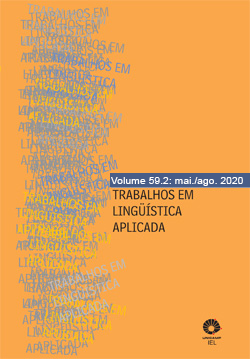Abstract
After the arisen and development of multiliteracies and critical literacy, it was overcome the concept of reading exclusively as decoding, transcription and search of the author´s intentions, that is, it is understood that reading is a critical, social and political practice. Based on this assumption, this study aims at proposing a reading activity of advertisements in Spanish as a foreign language based on the critical literacy perspective of Cervetti et al (2001) and on the visual literacy of Muffoletto (2001) for undergraduates of Tourism, Business Administration, Journalism and Social Communication. Five beer and soda advertisements were analyzed, as well as a proposal activity for reading and writing advertisements. It was also explained how the imperative mood is formed in Spanish, that is, it was hold together a critical literacy approach to the teaching of contextualized grammar. This study shows that teaching a foreign language is to go beyond the decontextualized and purely normative grammar contents.
References
ALMEIDA, D. B. L. de. (2009). Do texto às imagens: as novas fronteiras do letramento visual. In: PEREIRA, R. G; ROCA, P. (orgs.). Linguística aplicada: um caminho com diferentes acessos. São Paulo: Editora Contexto: 173-202.
ARAÚJO, A. D. (2011). Gêneros multimodais: mapeando pesquisas no Brasil. Linguagem em Foco. Fortaleza: EDUECE, 8(1): 13-23.
BRASIL. Orientações Curriculares para o Ensino Médio – Linguagens, códigos e suas tecnologias. Brasília: Ministério da Educação, SEB/MEC, 2006, vol. 1.
CALLOW, J. (1999). Reading the visual: An introduction. Image matters – Visual texts in the classroom. Newtown (Austrália): Primary English Teaching Association:1-13.
CASSANY, D. CASTELLÀ, J. M. (2010). Aproximación a la literacidad crítica. Perspectiva. Florianópolis, 28(2): 353-374, jul/dez.
CERVETTI et al. (2001). A tale of differences: comparing the traditions, perspectives, and educational goals of critical reading and critical literacy. Reading Online, 4(9). Disponible en: <http://www.readingonline.org/articles/artindex.asp?HREF/articles/cervetti/index.html> Consultado el 13 may. 2011.
DEL RÍO PEREDA, P. (1996). Psicología de los medios de comunicación: hacia el diseño sociocultural en comunicación audiovisual, Editorial Síntesis, Madrid, 431p.
DIONÍSIO, A. P. (2005). Gêneros multimodais e multiletramentos. In: KARWOSKI, A. M. GAYDECZKA, B; BRITO, K. S. (orgs.). Gêneros textuais: Reflexões e ensino. Rio de Janeiro: Ed. Lucerna: 159-177.
HALLIDAY, M. A. K. (1978). Language as Social Semiotic: The Social Interpretation of Language and Meaning. London: Edward Arnold.
HODGE, R. I. V. KRESS, G. R. (1988). Social Semiotics. Cambridge: Polity Press.
JEWITT, C. (2009). An introduction to multimodality. In: JEWITT, C. The Routledge Handbook of Multimodal Analysis. London and New York: Routledge, 214p.
KRESS, G. (2005). Alfabetismo y multimodalidad. Un marco teórico. En G. Kress, El alfabetismo en la era de los nuevos medios de comunicación. Granada, España: Ediciones Aljibe, p. 49-82, 2005.
KRESS, G. (2010). A social-semiotic theory of multimodality. In: Multimodality – A Social semiotic approach to contemporary communication. London and New York: Routlegde, 170p.
KRESS, G. (2011). ‘Partnerships in research’: multimodality and ethnography. In: Qualitative Research. London: June: 227–237.
KRESS, G. van LEEUWEN, T. (2006). Reading images: the Grammar of visual design. London: Routlegde.
KRESS, G. van LEEUWEN, T. (2001). Multimodal Discourse: The Modes and Media of Contemporary Communication. London: Edward Arnold.
MUFFOLETTO, R. (2001). An Inquiry into the nature of Uncle Joe´s representation and meaning.
Reading Online, 8(4). Disponible en: <http://www.readingonline.org/newliteracies/muffoletto/index.html> Consultado en: 12 oct. 2011.
OLIVEIRA, S. (2006). Texto visual e leitura crítica: o dito, o omitido, o sugerido. Linguagem & Ensino, 9(1): 15-39.
OVIEDO, G. L. (2004). LA definición del concepto de percepción en psicología con base en la teoría Gestalt. Revista de Estudios Sociales, no. 18, agosto de 2004, 89-96.
ROJO, R. (2009). Letramentos múltiplos, escola e inclusão social. São Paulo: Parábola Editorial.
SAUSSURE, F. (2006). Curso de lingüística geral. São Paulo: Cultrix. Traducción de Antônio Chelini, José Paulo Paes y lzidoro Blikstein. Edición consultado de 2006, disponible en https://edisciplinas.usp.br/pluginfile.php/4622783/mod_resource/content/1/Saussure16CursoDeLinguisticaGeral.pdf Consultado el 10 oct. 2019.
STOKES, S. (2002). Visual literacy in teaching and learning: A literature perspective. Electronic Journal for the Integration of Technology in Education. Pocatello (EUA), 1(1): 10-19. Disponible en: <http://ejite.isu.edu/Volume1, No1/pdfs/stokes.pdf> Consultado el 12 oct. 2011.
STREET et al. (2009). Multimodality and new literacy studies. In: JEWITT, C. (Ed.) The Routledge Handbook of Multimodal Analysis. London/New York: Routledge: 191-200.
van LEEUWEN, T. (2011). Multimodality. In: SIMPSON, J. (Editor). The Routledge Handbook of Applied Linguistics. London and New York: Routledge, 732p.
O periódico Trabalhos em Linguística Aplicada utiliza a licença do Creative Commons (CC), preservando assim, a integridade dos artigos em ambiente de acesso aberto, em que:
- A publicação se reserva o direito de efetuar, nos originais, alterações de ordem normativa, ortográfica e gramatical, com vistas a manter o padrão culto da língua, respeitando, porém, o estilo dos autores;
- Os originais não serão devolvidos aos autores;
- Os autores mantêm os direitos totais sobre seus trabalhos publicados na Trabalhos de Linguística Aplicada, ficando sua reimpressão total ou parcial, depósito ou republicação sujeita à indicação de primeira publicação na revista, por meio da licença CC-BY;
- Deve ser consignada a fonte de publicação original;
- As opiniões emitidas pelos autores dos artigos são de sua exclusiva responsabilidade.


